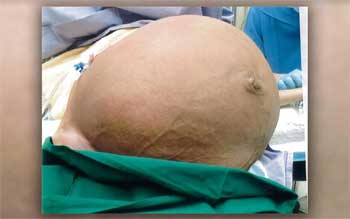- Home
- Editorial
- News
- Practice Guidelines
- Anesthesiology Guidelines
- Cancer Guidelines
- Cardiac Sciences Guidelines
- Critical Care Guidelines
- Dentistry Guidelines
- Dermatology Guidelines
- Diabetes and Endo Guidelines
- Diagnostics Guidelines
- ENT Guidelines
- Featured Practice Guidelines
- Gastroenterology Guidelines
- Geriatrics Guidelines
- Medicine Guidelines
- Nephrology Guidelines
- Neurosciences Guidelines
- Obs and Gynae Guidelines
- Ophthalmology Guidelines
- Orthopaedics Guidelines
- Paediatrics Guidelines
- Psychiatry Guidelines
- Pulmonology Guidelines
- Radiology Guidelines
- Surgery Guidelines
- Urology Guidelines
Doctors remove 28 kg 'Giant' Fibroid from woman's Uterus

Dr Poh Ting Lim at KK Women's and Children's Hospital in Singapore and colleagues have reported a so-called giant uterine fibroid weighing about 28 kilograms in a 53-year-old woman. The case has appeared in the BMJ case report. Medically a fibroid is termed "giant" when it weighs 25 lbs. (11 kg) or more.
Fibroids, or "uterine leiomyomas," are a type of benign, or noncancerous, the tumour of the uterus. They are the most common tumours arising from the female reproductive tract. However, giant myomas, which are greater than 11.4 kg in weight, are exceedingly rare. They may cause a pressure effect on surrounding organs, heart and lungs, which can be potentially life-threatening. Other symptoms include excessive bleeding during menstruation, pain during intercourse, frequent urination or a feeling of fullness in the lower abdomen can occur.
In this case, a 53-year-old woman with a massive uterine mass complicated by restrictive lung disease sought medical attention. The weight of the fibroid had made it difficult for her to move around and she was largely bedridden. The patent also complained of Dyspnoea on movement and at rest.
She underwent a total abdominal hysterectomy and bilateral salpingo-oophorectomy with frozen section and reconstruction of the abdominal wall by the gynaecologists and plastic surgeons.
The surgery to remove such a massive tumour was challenging, the report said. After the fibroid's removal, doctors had to perform plastic surgery to reconstruct the woman's abdominal wall, which had thinned after being so distended. The excised specimen weighed 27.8 kg, which included a benign subserosal leiomyoma measuring 64 by 50.5 by 15 cm.
The blood loss during surgery was about 7 L and her postoperative recovery was complicated by coagulopathy and haemorrhagic shock. This case illustrates the pivotal role of multidisciplinary care in the management of complicated surgical patients and the need for careful perioperative care. The patient was in good health and her abdomen was healing well two months after the surgery.
The largest fibroid ever reported weighed 140 lbs. (63.3 kg) and was removed from a patient postmortem in 1888, according to the case report. Among patients who survived the procedure, the largest fibroid ever removed weighed 100 lbs. (45.5 kg), according to the literature.
For more details click on the link: doi:10.1136/bcr-2017-224052

Disclaimer: This site is primarily intended for healthcare professionals. Any content/information on this website does not replace the advice of medical and/or health professionals and should not be construed as medical/diagnostic advice/endorsement or prescription. Use of this site is subject to our terms of use, privacy policy, advertisement policy. © 2020 Minerva Medical Treatment Pvt Ltd